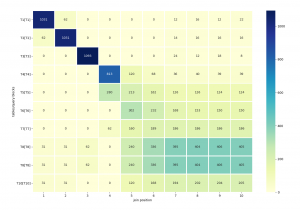There are n! possible ways to order n tables in a join. Of course, the optimizer won’t cost all of the permutations to find the best plan. It will rather limit its search space in order to produce a good enough plan within a reasonable amount of time.
The considered permutations are tracked in the CBO trace, like for example:
...
Join order[3]: T1[T1]#0 T2[T2]#1 T3[T3]#2 T4[T4]#3 T5[T5]#4 T6[T6]#5 T7[T7]#6 T8[T8]#8 T8[T8]#7 T10[T10]#9
...Generally, the tables with lower cardinality tend to be joined first (“Considering cardinality-based initial join order.”)
I’d like to share the Python script for aggregating and visualizing the number of times a table was considered on each position in the join. Notice that the scripts relies on some non-default Python modules: pandas, seaborn and numpy.
I wrote it, at first, for experimental purposes. But then it turned out to be useful for explaining why sometimes a plan with a lower cost wasn’t chosen. In such case, you can generate the heatmap and check whether the leading tables from the better plan were even considered as leading tables in the suboptimal plan. By the way, that’s exactly what can happen with some query transformations.
To demonstrate the usage, I’ll create 10 tables – t1 having the lowest cardinality and t10 the highest.
declare
i integer ;
begin
for i in 1..10
loop
execute immediate
'create table t' || i ||
' as select level n from dual connect by level <= ' || power( 4, i)
;
end loop ;
end ;
/Then I’ll generate the CBO trace for the cartesian join of these 10 tables:
alter session set tracefile_identifier = 'JOIN_ORDER' ;
ALTER SESSION SET EVENTS='10053 trace name context forever, level 1' ;
explain plan for select t10.* from t1,t2,t3,t4,t5,t6,t7,t8,t8,t10 ;
ALTER SESSION SET EVENTS '10053 trace name context off';The simplest way to produce the heatmap is as follows:
python join_permutations_heatmaps.py CBO_trace_fileBy the way, in the graph above, we can clearly see that the tables with fewer rows are the ones mainly considered for the leading positions.
If you’re an “ASCII type of person” you can specify the –text parameter to get the output in the text format:
python join_permutations_heatmaps.py --text CBO_trace_file
1 2 3 4 5 6 7 8 9 10
T1[T1] 1031 62 0 0 0 0 12 16 12 22
T2[T2] 62 1031 0 0 0 0 14 16 16 16
T3[T3] 0 0 1093 0 0 0 24 12 18 8
T4[T4] 0 0 0 813 120 68 36 40 39 39
T5[T5] 0 0 0 280 213 162 126 126 124 124
T6[T6] 0 0 0 0 302 232 168 153 150 150
T7[T7] 0 0 0 62 160 189 186 186 186 186
T8[T8] 31 31 62 0 240 336 395 404 406 405
T8[T8] 31 31 62 0 240 336 395 404 406 405
T10[T10] 31 31 0 0 120 168 194 202 204 205Last but not least, complex queries may contain many query blocks, each of which is costed separately. By default, the heatmaps will be generated for all of them. However, you can limit the scope by specifiying a query block to focus on: –qb QB.

This looks cool!
Interesting / strange that the bigger tables were considered for the first position join T8[T8] and T10[T10] while 3-7 weren’t (is it a typo that T8[T8] is there twice ?).
Kyle
Thank you, Kyle, for your feedback.
Well spotted – T8 appears twice in the heatmap, because I inadvertently referenced it twice (and omitted T9) in the query:
explain plan for select t10.* from t1,t2,t3,t4,t5,t6,t7,t8,t8,t10 ;Unlike T10, T3 indeed never appeared in the first position. A possible explanation could be that there’s a heuristic rule to allocate a relatively small number of permutations where the biggest tables are being pushed away from the tail toward the first positions. A rationale – I’m just speculating – might be to examine the search subspace in which is, generally, less probable, though not impossible, to find an optimal plan.